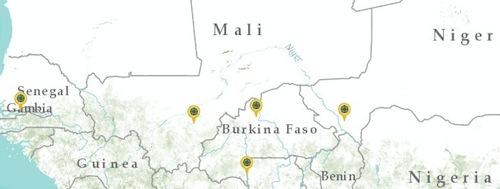West Africa is made up of 16 countries, namely Benin, Burkina Faso, Cote d’Ivoire, Cape Verde, The Gambia, Ghana, Guinea, Guinea-Bissau, Liberia, Mali, Mauritania, Niger, Nigeria, Senegal, Sierra Leone and Togo.

click to explore ccafs sites in west africa
Of the total population of about 290 million, approx. 75% lives in the humid and sub-humid zones, 20% in the semiarid zone (the Sahel), and 5% in the arid zone. The large rural populations, which depend on rain-fed cereal-based agriculture in the sub-humid and semi-arid zones, and on pastoralism in the arid zones, are highly vulnerable climate variability and sensitive to climate change. Episodic climate shocks-primarily drought- have led to major food crises in the drylands of this region, with resultant loss of lives and livelihoods, and a cycle of disaster relief that compete with the long-term development. Indeed, the climate of West Africa is characterized by a strong latitudinal rainfall gradient that determines cropping systems, and by dramatic fluctuations in the rainfall regime at multi-decadal time‐scales, therefore amplifying the substantial year-to-year rainfall variability. Climate change will have far-reaching consequences for the poor and marginalized groups among which the majority depend on agriculture for their livelihoods and have a lower capacity to adapt. A major challenge is increasing agricultural production among resource-poor farmers without exacerbating environmental problems and simultaneously coping with climate change.
The Region suffers from widespread land degradation, particularly in the semi-arid Sudan-Sahelian zone, but benefits from policy support for regional drought management and for intra-regional trade facilitated by a common currency across the francophone countries.
Key Activities
In West Africa, CCAFS program operates in five pilot countries, namely Burkina Faso, Ghana, Mali, Niger and Senegal.
The regional program aims to identify partnerships, opportunities for and impediments to action, measures and communication channels needed to sustain and broaden successful outcomes, knowledge and capacity gaps, and potential policy responses to support adaptation and mitigation to climate change.
A first step consisted in documenting current status and trends of climate change adaptation and mitigation in agriculture in selected countries. Mechanisms to ensure coherence among themes from field to national and regional levels have been initiated, including a cross-organization team approach to planning and implementation, common conceptual framework, joint fieldwork at shared sites, sharing of data, results, and up-to-date knowledge on climate change with key stakeholders to inform decision making from community to sub-national to national and regional levels. This work is organized around four major components: (1) Test of adaptation and mitigation practices and technologies through participatory action research; (2) Capacity strengthening; (2) Decision making support for policy makers; and (4) Communication.